
Fly with us
Dakota Norway has the Norwegian Civil Aviation Authority's approval to operate LN-WND and allow the public to take part in adventure flights. Here you get close to aviation history.
Passengers and aircraft are fully insured. The price for these trips is based on what the operation of the aircraft costs. The foundation also has LT's approval to fly so-called from A to B trips. Such trips are to be regarded as a joint venture. The aircraft is approved for 19 passengers and a crew of four, two pilots and two cabin crew.
Flights for the 2024 season - click here
Here you get a full overview of all our flights in 2024, you can also download the calendar directly to your calendar.
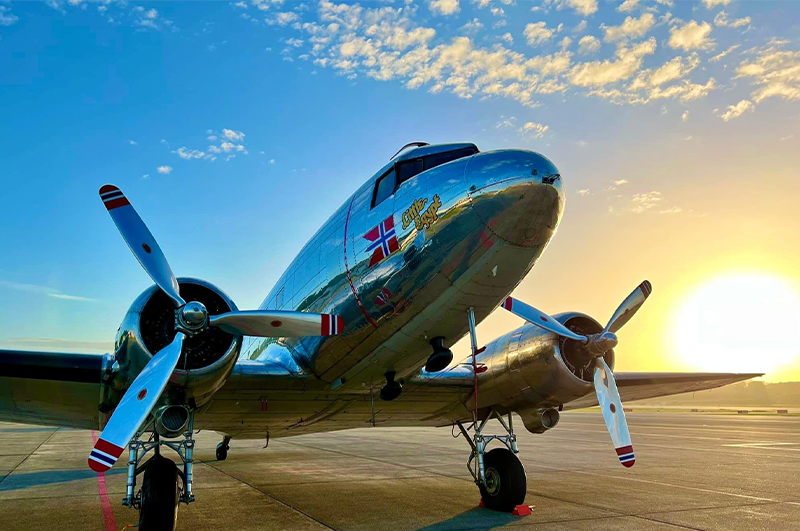
Prices
Round trips with the Dakota involve about 25 minutes in the air. In addition, there is time for boarding, safety information on board, taxiing to the runway, clearance from air traffic control and taxiing back to the departure point at the end of the flight.
Prices for the 2024 season are:
Adults over 15 years: NOK 900.
If you have signed up for a membership in advance, the price is 800.
Children: 2 to 15 years: Kr 450.
Children under the age of two sitting on your lap fly for free.
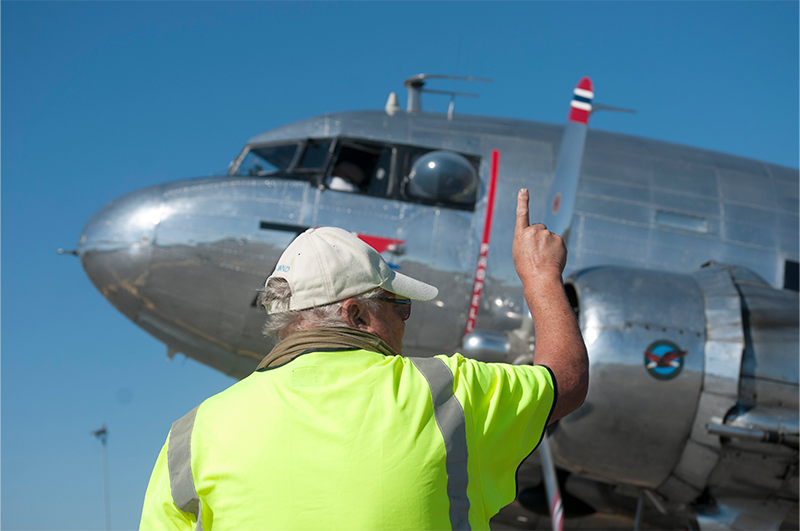
Prices Membership
According to the rules for foundations, the articles of association for Dakota Norway Venneforeningen state that you must be a member to join and fly.
The annual membership renewals from members give Dakota Norway an important and solid financial backbone.
For the first flight, membership is included in the ticket price of NOK 900.
We want as many people as possible to maintain their membership in the years following their first flight.
Prices of supporting memberships:
Single member: Kr 350,-
Family membership: NOK 450,- (applies to children up to 15 years)
Lifetime membership: NOK 3500,-
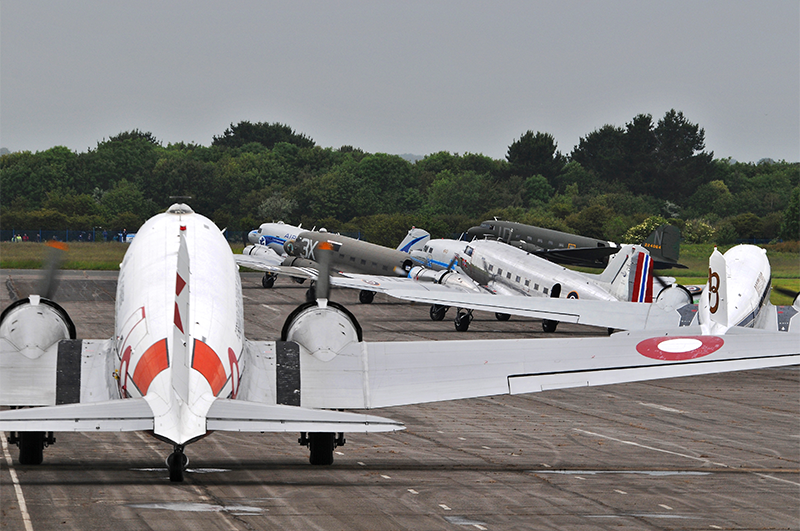
When does the Dakota fly?
The Dakota flies on Sundays and some Wednesdays from mid-May through October.
The experience flights start at Torp at 12:00.
You can't pre-book a seat on the plane - we operate on a first come, first served basis.
At the Dakota hangar, you pay your fare and receive a boarding pass. With it, you need to drive a few hundred meters in your own car to the airport gate where you can board the plane.
Dakota Norway's ground crew will be there to help you on your way.
Stay tuned to this website. The relevant dates and times will be published here.

Where can you find us?
If you've flown the Dakota before, you'll have met up at our clubhouse north of the control tower at Torp.
This is no longer in use.
Dakota Norway has an older, military hangar on the east side of Torp Airport. Unfortunately, there is no public transportation here.
The adventure flights are controlled from the Dakota hangar. You'll find signs to the hangar if you follow these directions (see also map):
Exit at junction no. 40 on the E-18. Whether you're coming from the north or the south, after the exit from the highway, follow Tassebekkveien straight east.
After about 2,400 meters you will reach a small hilltop where there is a spur road to the right. At the intersection there is a pole with several small signs, including "Dakota hangar."
This road is called Bredholtveien.
Follow this - you'll first come to a gate that is open when there are Dakota flights.
After the barrier: take the second road to the right. After 200 meters you will arrive at the hangar.
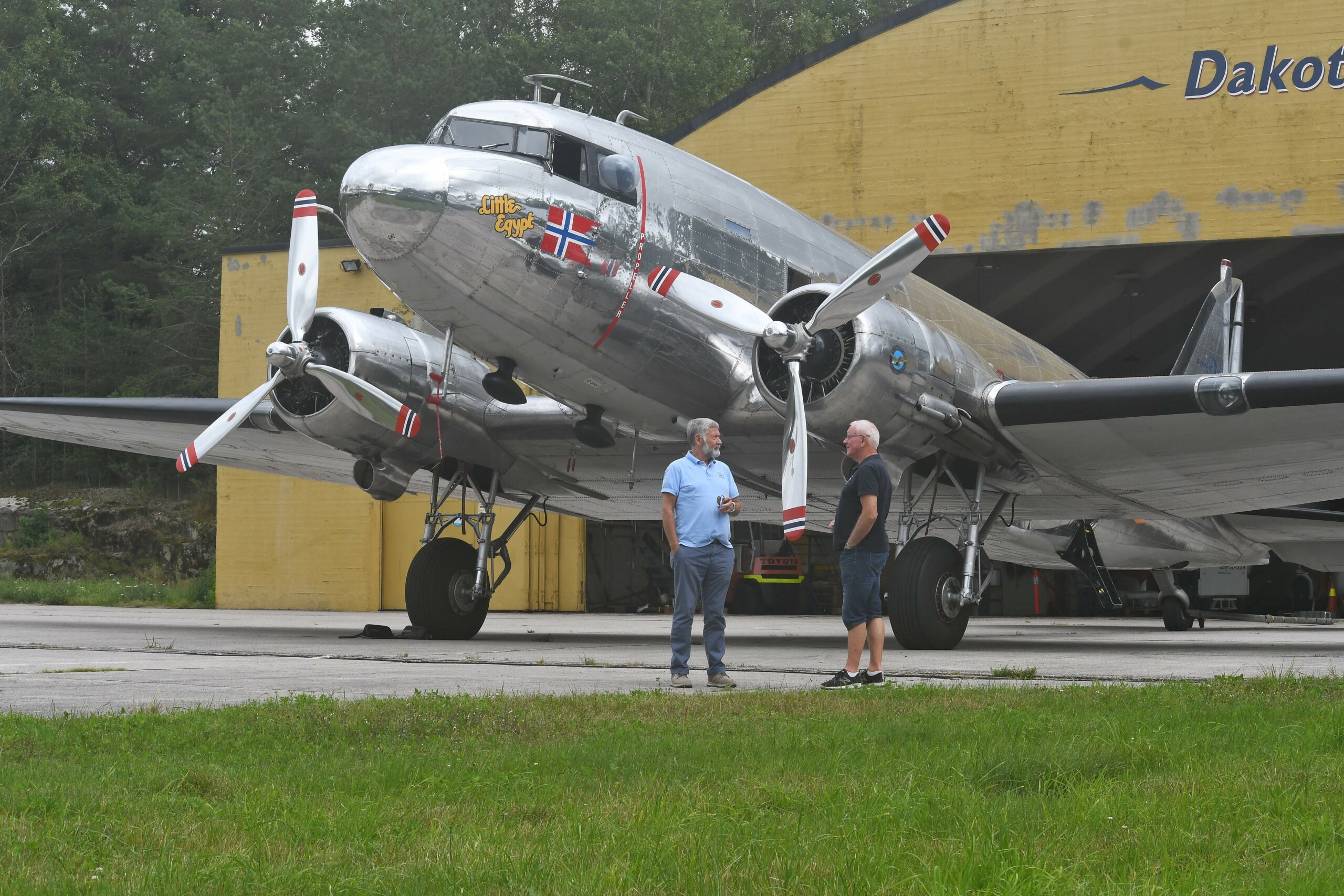
Risk understanding
Here you will find information that must be read and signed before flying. The information is also summarized in the video below.
The following info must be read before you can fly with Dakota
The following information must be read before you can fly with the Dakota.
The form must be signed to confirm that you have understood the information and accept the conditions for flying.
(The information is summarized in two videos on the website: One in Norwegian and one in English).
Introduction
Dakota Norway's C-53D-DO was built in 1942 and originally certified according to the requirements of the time.
The DC-3 came in several versions, but the common denominator is that this was the world's first real "airliner", the first efficient passenger aircraft. The aircraft had several revolutionary design features, including a very strong, round-shaped fuselage, and in 1944, one completed aircraft rolled out of the Douglas factories every 45 minutes.
The Norwegian aviation authority, the Civil Aviation Authority (CAA), now certifies the aircraft from year to year according to current regulations for private aircraft.
A flight with Dakotaen cannot be compared to traveling with a commercial airline. But even with us, passengers and aircraft are fully insured. This includes insurance for passenger accidents and third-party liability in accordance with current regulatory requirements.
If the tour is canceled at the aircraft's home base (Sandefjord Airport, Torp or other airport where we are in place to do adventure flights) - i.e. before the start of the trip, the cost of the trip will be refunded.
If the aircraft experiences technical problems at another airport during an A to B trip, the foundation will not be able to pay for the members' return journey. This must therefore be arranged and paid for by the individual member. The Foundation will of course seek to help all members who cannot get home.
Matters covered in a consent form that you must sign before the trip.
The aircraft has a certificate of airworthiness and is maintained in accordance with current regulations, but it is important that those who fly with us are aware that they are flying an aircraft that was designed in the mid-thirties and that it therefore does not meet all the current requirements for safety and performance required by modern aircraft used by today's commercial airlines.
At the time of writing in spring 2019, it is 84 years since the Dakota aircraft was first flown and type-approved. In other words, it was built at a time when requirements for emergency exits were different from today. That's why the aircraft is currently approved for 19 members, whereas it originally had 28 passenger seats.
You will receive a safety briefing on emergency exits and safety equipment from the cabin crew before departure.
So it's important to understand and accept that you're flying an aircraft from a different era, and that its equipment is consequently different from what applies in today's aviation.
So what's the difference between a Dakota and a Boeing 737 taking you to London or the Canary Islands?
First and foremost the size and seat capacity, as well as the fact that the Dakota is a slow-moving aircraft with two piston engines and propeller drive, not a jet.
There is also an 84-year gap in aircraft design, technology and philosophy that separates the aviation workhorse of 1942 - the Dakota - from today's equivalent: The Boeing 737.
What are the risks of flying Dakota and what has been done to minimize the risks to an acceptable level?
Firstly:
In 1942, you could be shot at in such a plane. That doesn't happen today.
Second:
An engine can stop. The pilots who fly the Dakota are all active or retired professional pilots with a background in civil aviation and/or the armed forces. They are highly experienced and perform the flights with true enthusiasm because this is a hobby, not a job. No one is paid to work around or in the Dakota. There are only enthusiasts working to fulfill the foundation's only goal: To keep the Dakota airworthy.
Despite their long experience with the Dakota (which has now flown for more than 30 years in Norwegian airspace), the pilots have annual check-outs and proficiency tests under the same organization as today.
Every year, the pilots train in the world's only certified DC-3 simulator in the Netherlands. Unlike the aircraft, the simulator is state-of-the-art and provides highly realistic scenarios that pilots can train on safely on the ground without exposing aircraft or passengers to destruction or danger.
The Dakota can be flown on one engine if the other stops, and the pilots are trained specifically to deal with such a situation.
On a flight, you may encounter fog/bad weather:
Naturally, the weather forecast is checked before every flight. And in the pilots' long experience lies the habit of continually assessing and planning the route and the weather conditions that may arise. In this way, they work to avoid ending up in a weather situation that may require the flight to be rescheduled or canceled.
Maintenance:
The Dakota spends the winter season from October to May in the hangar.
Here it receives thorough inspection, maintenance and upgrades.
Engines, propellers, airframe, electrical and hydraulic systems are inspected according to set maintenance cycles. In such contexts, there is talk of a certain number of flight hours or days between replacement or inspection and resetting of components.
Technical crew:
Dakota Norway has its own certified technicians for this particular aircraft type. They can carry out troubleshooting, repairs and replacements and then sign off the aircraft as airworthy.
In aviation, there is one valid slogan: If there is doubt, there is no doubt.
In other words - don't take any chances if you suspect that a component should be replaced.
Cabin and ground crew:
In its certification, the Dakota can be flown without a cabin crew. However, Dakota Norway has decided that there must be two cabin crew on board at all times. They provide safety information before the flight and are trained in handling the aircraft's safety equipment, emergency exits, first aid and firefighting. All are certified by Dakota Norway's chief operating officer for service in the cabin.
The same crews alternate as ground crew during refueling, start-up, departure and arrival of the aircraft. They all wear yellow vests and ensure that members who are about to fly or have flown are guided to the places at the airport they are allowed to go.
Propellers in motion:
The Dakota has two radial engines, each with its own large propeller. This is one of the biggest hazards associated with aircraft of this type.
But Dakota Norway's crews have frequent training and a strong focus on ensuring that dangerous situations around the propellers are NOT allowed to occur.
In any case, the propellers are never in operation while members are on their way to or from the airplane, only after everyone who is to fly has boarded and the door is closed.
Your own health:
Any evacuation of the aircraft depends on the members being able to take care of themselves. Should there be any doubt as to whether any mobility impairment may make this difficult, this can be discussed with you.
Please do not react negatively to such a question - it will only be asked to ensure the safety of yourself and other passengers.
Dakota Norway wishes you a truly enjoyable and safe trip with Norway's only airworthy Dakota.
I have read, understood and accept the terms and conditions for flying with LN-WND
Download risk form in PDF here
PDF file
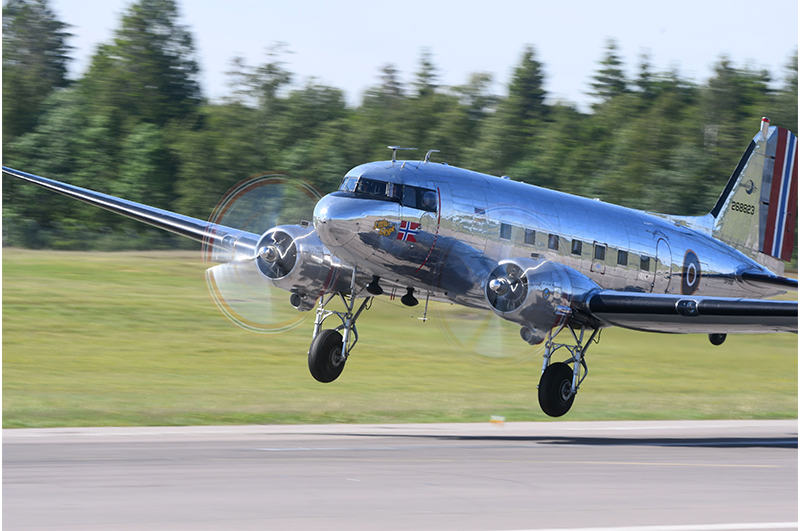
Risk Information
This information is to be read, understood and signed prior to flying with DC-3. The information is also explained in the video below.
Following information to be read before flying
RISK ACKNOWLEDGEMENT
(ENGLISH VERSION)
The following information must be read prior to flying with the Dakota.
Prior to flying with the Dakota, you must sign an informed consent - showing that you accepted and understood what it implies flying in this vintage aircraft.
(The essential information of this document can also be found in a video on the web page).
Dakota Norway's C-53D-DO was manufactured in 1942 and originally certified according to the demands for passenger aircraft of that time. The aircraft came as several models, but the main issue was that this became the world's first, real airliner, the very first effectively passenger aircraft. The aircraft came with several revolutionary constructions- and design details, such as a very firm, strong round airframe, and wings. During 1944 one brand new Dakota rolled off the assembly lines of the Douglas Aircraft Company every 45th minute.
The Norwegian Civil Aviation Authority (CAA Norway) is surveying the maintenance and operation of the aircraft according to current rules for private airplanes.
Flying with the Dakota is not comparable to flying on a commercial airline. Though all passengers and the aircraft itself has full accident coverage, including passenger accident and third-party responsibility according to the current demands of the authorities.
If the trip is canceled at the plane's home base (Sandefjord Airport, Torp or another airport where we are available to do adventure flights) - i.e. before the start of the trip, the cost of the trip will be refunded.
Should any technical problems occur at another airfield during an A to B -trip, the Foundation will not cover the members return-journey. This must be organized and paid for by the individual member. The Foundation will of course do their best to assist members who will not be able to get home. Please read our members criteria, published at dakotanorway.no.
Conditions covered in the informed consent you must sign prior to flying with us.
The aircraft carries a certificate of airworthiness and gets its maintenance according to current rules. It is of great importance that persons flying along with this aircraft acknowledge this is an aircraft designed in the middle of the thirties. And from this reason it will not comply with all the demands of todays modern aircrafts, used by commercial airlines.
When this info was written during the summer of 2019, it is 84 years since the Dakota type of aircraft had its maiden flight and was given a type certificate. In other words - it was built in a time when for instance demands for emergency exits were of quite another standard than for our modern times. This is one of the reasons that the aircraft today is certified for 19 passengers, not 28 as it originally was.
You will receive a safety demonstration of emergency exits and safety equipment by the cabin attendants ahead of a trip, like the ones you are familiar with on ordinary commercial airliners.
In other words: It is important that you have understood and accepted that you fly along in an aircraft from another area of time, and that it is equipped otherwise that today's aviation.
So - what differs the Dakota from a Boeing 737 taking you to a sunny holiday in Spain?
Mainly the seat capacity, and to this, the Dakota is a slow-moving airplane, piston engined with two propellers - not a jet powered aircraft. The differences in aircraft design and philosophy is a gap of 84 years, presenting the Working Horse of aviation anno 1942 compared with its opponent of today, the Boeing 737.
What are the risks you take on by flying the Dakota, and what have been done to minimize these risks to a level of acceptance?
It is of importance for us to inform you on what differs our operation of an old airliner from today's aviation.
Firstly - in 1942 you could be shot at flying in such a plane. That won`t happen today.
Secondly: One engine might quit. The pilots are all active commercial airline pilots or retired as such, and/or ex military pilots. They have a vast experience, and doing their flying with a true enthusiasm, doing this as a hobby, not a job. Nobody gets paid to do his work on the Dakota, we all are enthusiasts going for one goal: To keep the Foundations main item alive: To keep this Dakota airworthy.
Despite long experience on the Dakota (which now have been flying more than 30 years in Norwegian airspace with the Foundation organizing the activity), they all conduct annual proficiency checks with this type of aircraft. They also undergo a thorough training program in the worlds only DC 3 simulator in Holland, approved by the European Civil Aviation Authorities. Unlike the aircraft, this simulator is a state of art, and gives very realistic situations to which the pilots can do their training within the safety of staying on ground, and without exposing the aircraft or passengers to danger.
This Dakota can be flown on one engine, and the simulator training is aiming to keep the pilots capable to handle such a demanding situation.
During a flight you might run into deteriorating weather conditions or fog. The weather forecast will of course be checked out ahead of the flight. Within the pilots experiences is also the habit to continuous considering and planning for the further flight, and as a part of this, following the weather development. In this way the pilots gains not to get into bad weather demanding the trip to be diverted or canceled. The Dakota can not be flown into clouds, but have to stick to Visual Flying Rules (VFR). The pilots are flying and navigating the trip based on visual references.
Maintanence
The Dakota is parked in our hangar from October to May. Dakota Norway has its own Maintenance Organization. The aircrafts receives a thorough check, maintenance and upgrading. Engines, propellers, airframe, electrical and hydraulic systems have their specific maintenance cycles. A certain amount of flying hours between changes, inspections and resettings directs this work.
Technical crew:
Dakota Norways technicians are certified for this very type of aircraft. They do failure seeking, repairs and changes, whereafter they sign out the aircraft as airworthy. If there should be a doubt wether a component should be changed, we just do it.
Cabin- and groundcrew
The Dakota is certified to fly without a cabin crew. The Foundation has, however, decided that two cabin attendants should stay onboard on every flight. They are certified by the Chief Pilot of the Foundation to handle the safety equipment, emergency exits, first aid and fire fighting.
The same group of volunteers alternates as ground crew during refueling, start up, departure and arrival of the aircraft. They all carry yellow jackets, and are guiding the members prior to and after a flight to the areas at which they are allowed to stay at the airfield.
Propellers in motion
The Dakota carries two radial engines, each with a rather large propeller. They are of the most hazard item regarding this aircraft.
The ground crew are trained and focuses continuously for not letting any danger happen regarding the propellers. Anyway - the propellers will never be in motion during the members boarding or disembarking the aircraft, and the engines starts only when the door is closed.
Your own state of health
In the case of an emergency making an evacuation necessary, this demands that everybody on board can take care of themselves. Should a doubt be raised on the subject of a possible disability, this item may be addressed to you. Please don't be upset to this, it is for yours and other passengers' safety.
If you have any questions - don't hesitate to ask us.
Dakota Norway wishes you a pleasant trip on the only flying Norwegian example of the Dakota.
I have read, understood, and accept the terms for flying on LN-WND
Download risk form PDF
PDF file for download
Film by: Knut Åshammer. Aviation safety Norwegian
Video by: Knut Åshammer. Flight safety english
safety onboard
The Dakota Norway Foundation gives high priority to flight safety. Our DC-3 is maintained according to the same guidelines as modern commercial airlines. On our member flights, there is always a cabin crew to ensure safety on board. Before each flight, the cabin crew will conduct a safety demonstration. Please take a look at our "Safety Cards", emergency exit location and emergency equipment location before you fly with us.


